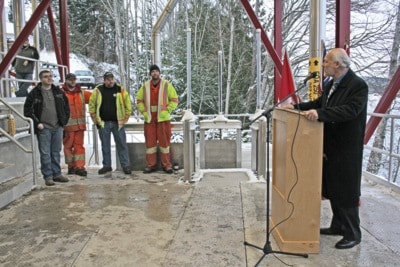The Town of Ladysmith is a big step further along on its way to providing secondary sewage treatment after receiving a $5.2-million grant from the federal government last week.
A state-of-the-art secondary sewage treatment system — the first of its kind in North America, according to a press release — is being built in Ladysmith, thanks to more than $5.2 million from Canada’s Gas Tax Fund.
The town is upgrading its present current treatment plant to secondary treatment, reusing or continuing to use components of the existing plant while building new structures and processes to provide full secondary treatment, explained Mayor Rob Hutchins.
The total cost of the upgrade to secondary treatment and additions is about $21,000,000, according to Hutchins.
The town has completed or nearly completed the first two phases at a cost of $5.5 million, and this final phase is estimated to cost between $14 million and $16 million.
The $5.2 million from the federal government will help complete the third phase, and Hutchins says the remainder of the funds will come from town reserves, additional grants and/or borrowing.
Nanaimo-Alberni MP James Lunney was in Ladysmith Jan. 19 to announce the federal funding, along with Parksville-Qualicum MLA Ron Cantelon, Union of British Columbia Municipalities (UBCM) board member Joe Stanhope and Hutchins.
“This [grant] is here to see this project go ahead to complete your water treatment program here, add some secondary treatment to create improvements that will bring the entire program up to provincial and federal standards,” said Lunney. “I understand there’s an energy component to this project as well. This project is going to be extremely important for the community of Ladysmith.”
Stanhope spoke about the importance of the Canada Gas Tax Fund in helping keep property taxes from rising, as it provides much-needed funds for municipalities.
“This is a very important fund because the only source of revenue municipalities and local governments have is property tax,” he said. “Rules and regulations are getting more difficult, costing more money, a lot of the old infrastructure — 80 per cent across Canada — is due for repair. This fund is really helping all of us very much, helping keep our property taxes low, so it’s very important. It’s helping us close the gap on our infrastructure deficit.”
These funds will save every single property owner in town $2,300 because the town won’t have to raise the money for the upgrades through taxation, explained Mayor Rob Hutchins.
“The Canada Gas Tax Fund represents the federal government’s commitment to invest in our community and help us upgrade and rebuild our infrastructure so we can do a better job and lessen our impact on the environment, and we are so thankful for it,” he said. “For far too long, our community, like too many communities on the west coast of B.C., discharged our sewage into harbours like this.”
Sewer lines were built in Ladysmith in 1902, and for the next 64 years, raw sewage spilled out into an outflow where the Ladysmith Community Marina now sits, explained Hutchins.
At one time, the harbour produced an abundance of clams and oysters, he noted.
“This once-great aquaculture industry languished because of our historic failure to do the right thing, as we continued to treat this beautiful harbour as a disposal site for our waste,” he said. “Since 1966, we have been doing better. We have learned from our mistakes, with the construction of a treatment plant on this site and millions of dollars of upgrades. We have been making progress.”
In the past three years, the town has spent $5.5 million dollars upgrading the water treatment plant in two phases, explained Hutchins.
“However, this funding today will allow us to finally move forward with the third phase, full secondary treatment,” he said. “It’s going to help us restore the health of this harbour, it’s going to help us establish thriving marine life in this harbour and hopefully not too far in the distant future ... we’re going to be able to once again harvest the rich bounty that is available here and at the same time, we’ll again honour, respect this gift we share with the Stz’uminus First Nation.”
This is the largest single gift the town has received, according to Hutchins.
The earliest construction on the plant can begin is September, explained Hutchins.
A number of steps must be completed first, including completion and acceptance of the Liquid Waste Management Plan by the Ministry of the Environment, final design of the plant and the construction tendering process.
During the funding announcement, Deputy Mayor Duck Paterson acknowledged and thanked retired Public Works manager Joe Freisenhan, who worked very hard to make this possible.
